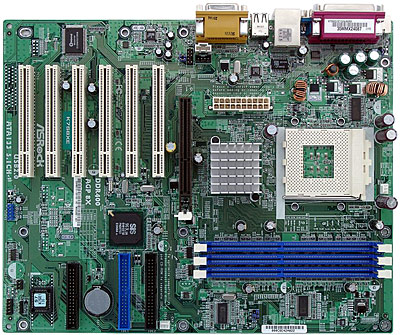 |
||
|
||
| ||
The board looks ascetic - there are no superfluous features, components
or settings. It's a bit difficult to describe such solutions as they have
nothing to attact attention with. They simply work. Maybe not that fast as
others but they work. Or do not work. This is the only criterion one can
take into account when choosing such boards. Our sample of the ASRock K7S8XE
does work :).  The layout is not very convenient - the FDD and IDE connectors are behind the PCI slots, the audio connectors and a power supply one are put behind. It's not easy to reach some jumpers when the board is already installed. Their functions are indicated on the PCB. The 2-phase switching voltage regulator incorporates 3 capacitors of 3300 uF and 4 of 1500 uF. There are also voltage regulators of the AGP bus (2 x 1000 uF) and of the memory (1x1000 uF and several less capcious ones). The IEEE1394 controller and its connectors didn't get included in the final design though the space for them is left. The board measures 305x245 mm ("wide ATX", 9 fastening screws, the front edge doesn't hang loose). System monitoring is supported by Winbond W83697HF chip. It controls:
The K7S8XE inherits the PCB from its predecessor K7S8X based on the SiS 746FX chipset. Thus, the K7S8X and K7S8XE differ only in the north bridge. There are also K7S8X rev 3.0 and K7S8XE rev 3.0 boards based on the SiS 746FX and SiS 748, but they are built on a different, smaller, PCB (narrow ATX). So, the K7S8XE has two sisters based on the same chipset but of another revision and PCB, and one twin built on the older SiS 746FX chipset.
|
|||||||||||||||||||||||||||||||||||||||||||||||||||||||||||||||||||||||||||||||||||
| jumpers and switches | Jumper to clear the CMOS | ||
| FSB clock speed jumpers | 100, 133, 166, 200 MHz | ||
| Jumpers for starting up PC from USB devices | |||
| BIOS based on AMI v3.31a | Setup of memory timings | + | CAS Latency |
| Setup of memory frequency | + | Auto, 100, 133, 166, 200 MHz | |
| Setup of AGP bus | - | ||
| Setup of PCI bus | - | ||
| AGP/PCI frequency setup | - | ||
| PCI IRQ manual assignment | - | ||
| FSB frequency setup | + | 50-248 MHz in 1MHz steps | |
| CPU clock ratio | - | ||
| CPU voltage control | - | ||
| DIMM voltage control | - | ||
| NB voltage control | - | ||
| AGP voltage control | - | ||
We used the BIOS 1.20 as the latest available version.
Write a comment below. No registration needed!
|
Article navigation: |
| blog comments powered by Disqus |
| Most Popular Reviews | More RSS |
 |
Comparing old, cheap solutions from AMD with new, budget offerings from Intel.
February 1, 2013 · Processor Roundups |
 |
Inno3D GeForce GTX 670 iChill, Inno3D GeForce GTX 660 Ti Graphics Cards A couple of mid-range adapters with original cooling systems.
January 30, 2013 · Video cards: NVIDIA GPUs |
 |
Creative Sound Blaster X-Fi Surround 5.1 An external X-Fi solution in tests.
September 9, 2008 · Sound Cards |
 |
The first worthwhile Piledriver CPU.
September 11, 2012 · Processors: AMD |
 |
Consumed Power, Energy Consumption: Ivy Bridge vs. Sandy Bridge Trying out the new method.
September 18, 2012 · Processors: Intel |
| Latest Reviews | More RSS |
 |
Retested all graphics cards with the new drivers.
Oct 18, 2013 · 3Digests
|
 |
Added new benchmarks: BioShock Infinite and Metro: Last Light.
Sep 06, 2013 · 3Digests
|
 |
Added the test results of NVIDIA GeForce GTX 760 and AMD Radeon HD 7730.
Aug 05, 2013 · 3Digests
|
 |
Gainward GeForce GTX 650 Ti BOOST 2GB Golden Sample Graphics Card An excellent hybrid of GeForce GTX 650 Ti and GeForce GTX 660.
Jun 24, 2013 · Video cards: NVIDIA GPUs
|
 |
Added the test results of NVIDIA GeForce GTX 770/780.
Jun 03, 2013 · 3Digests
|
| Latest News | More RSS |
Platform · Video · Multimedia · Mobile · Other || About us & Privacy policy · Twitter · Facebook
Copyright © Byrds Research & Publishing, Ltd., 1997–2011. All rights reserved.